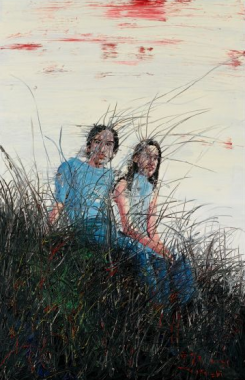New Collectors Like Shanghai Billionaire Liu Yiqian Stun Auction Market Observers#

This weekend, Sotheby's will hold its wide-ranging spring auctions in Hong Kong, which are expected to attract New Chinese Collectors from mainland China in droves. As Jing Daily has written in our coverage of the run-up to some of these upcoming auctions, and as articles this week from Bloomberg and the New York Times have also pointed out, all eyes are what these mainland Chinese collectors choose to buy, how much of it they buy individually, and how far above high estimates they're willing to go to get their hands on historical or culturally significant pieces.
As the New York Times notes today, the last year has seen a "tectonic shift" in the Chinese art auction market, as the formerly dominant western collectors have lost out to Chinese new collectors who apparently pay no attention to estimates and have -- in recent auctions -- pushed certain items, like a hand scroll signed by Yu Zhiding that went for nearly 23 times above its high estimate, to stratospheric prices. This determination, says the author of the article, reflects the importance placed on "repatriating" items that were sold, smuggled or looted from China during the waning years of the Qing Dynasty.
Judging from last week’s buying binge in New York, which the Chinese attended in such large numbers that Christie’s decided to hold the auction in the vast room usually reserved for Impressionist and Contemporary art, the days when Westerners with a great eye and the required cash could amass fabulous hoards of Chinese art are probably over. Roughly two thirds of the 611 lots that came on the block in a mammoth two-day sale went to Chinese dealers and collectors. They bought across the board, in every category, at every financial level.
The ultimate symbol of the fierce Chinese determination to buy back their art that strayed to the West in the quasi-colonial days of the 19th and early 20th century is the acquisition of a hand scroll titled Chan Yue tu, “Happiness through Chan Practice,” which was signed by Yu Zhiding in the early 1700s. Professional circles are convinced that the buyer is Liu Yiqian, the Shanghai billionaire. Estimated by Christie’s to be worth $120,000 to $150,000 plus the sale charge, the hand scroll made $3.44 million.
The article goes on to point out that Chinese collectors are now buying once-taboo items like ancient bronzes, mostly driven by the desire to bring home objects that may have been looted around the time of World War Two.
Mental associations with a recent past underlie the massive entry of Chinese collectors into fields where almost none would have ventured two decades ago.
Ancient bronzes, if retrieved from underground caches, were taboo because the recovery process violated ancestral tombs. These are now seen as part of the cultural heritage unlawfully removed from its homeland. Last week at Christie’s, the three finest pieces went back to China. All came from the collection of the late Mr. Sackler and had earlier been ensconced in English, American or Japanese collections. Memories are long in the Orient and such provenances, which come as reminders of bygone foreign intrusions, still tend to make Chinese blood boil.
A superb bronze vase cast with an abstract pattern in the fourth or third century B.C. sold for $119,500 to a major mainland collector. Later a powerful Western Zhou food vessel with stylized dragons in low relief caused a bigger stir. Christie’s noted that it was consigned from Ashiya, Japan, and had entered the Japanese collection before World War II. Rightly or wrongly, this inevitably conjures visions of the Japanese rampaging in war-torn China. A Beijing collector paid $386,500, twice Christie’s high estimate, for the privilege of returning the remarkable vessel to its homeland.
The article concludes with a provocative thought by Theow Tow of Christie's. Theow, remarking on his surprise at the rapid pace with which Chinese collectors have dominated the Chinese art market, says, “We just witnessed a tectonic change.” So what could be the end result of this "tectonic change"? We think it would depend heavily on the type of Chinese art. Bronzes and Buddhist sculptures are less likely to end up in homes, but will likely end up in official institutions like the National Museum in Beijing. However, it's likely that buyers who focus on scroll paintings, antiquities, and the traditional arts -- as well as modern and contemporary Chinese art -- will put them in their houses or in private museums.
Why do we say "private museums"? Because of remarks in recent Chinese-language interviews, like Artron's interview with billionaire collector Liu Yiqian's wife Wang Wei, which Jing Daily translated last fall. In that interview, Wang said a major motivation for the collection that she and Liu were amassing was their desire to open a private museum. Additionally, Chinese art critics like Li Xianting have said that reforming arts education in China will ultimately be the responsibility of individuals and private institutions, as it is an extremely low priority for the central government.
As a result, expect to see older collectors -- who are less interested in being actively involved in arts education -- focusing mostly on bronzes, ancient sculptures, and occasionally scroll and ink paintings. Younger and middle-aged collectors are less likely to focus only on one type of artwork, and will buy more impulsively, but as we've seen in recent auctions in New York and London, many of the younger, active Chinese bidders are collecting more modern and contemporary Chinese art. In Hong Kong at the Sotheby's spring auctions, keep an eye on people like Liu and Wang. We have a feeling Wang has her eyes on the Liu Ye piece Jing Daily featured in our "Top 10 Lots to Watch."